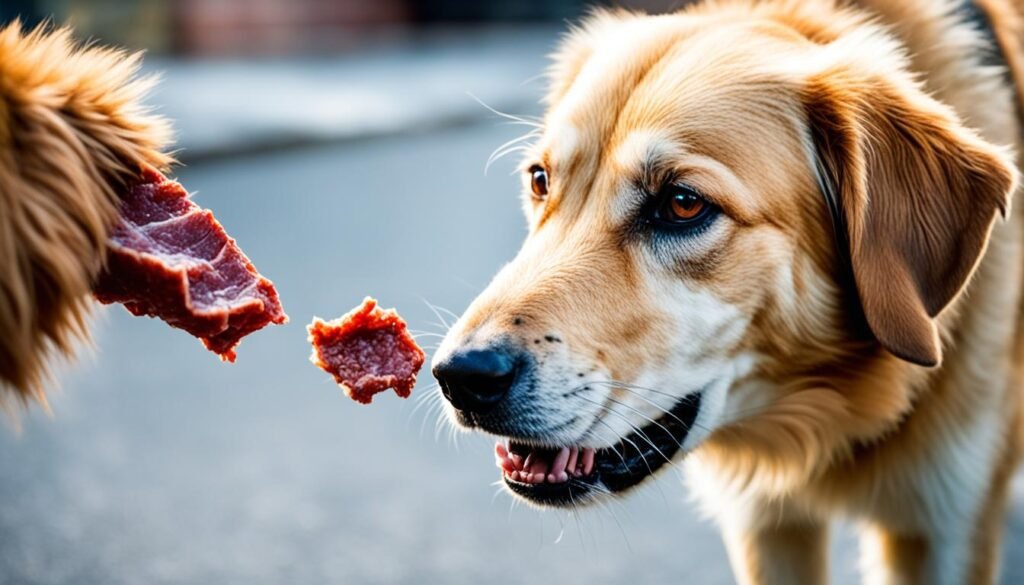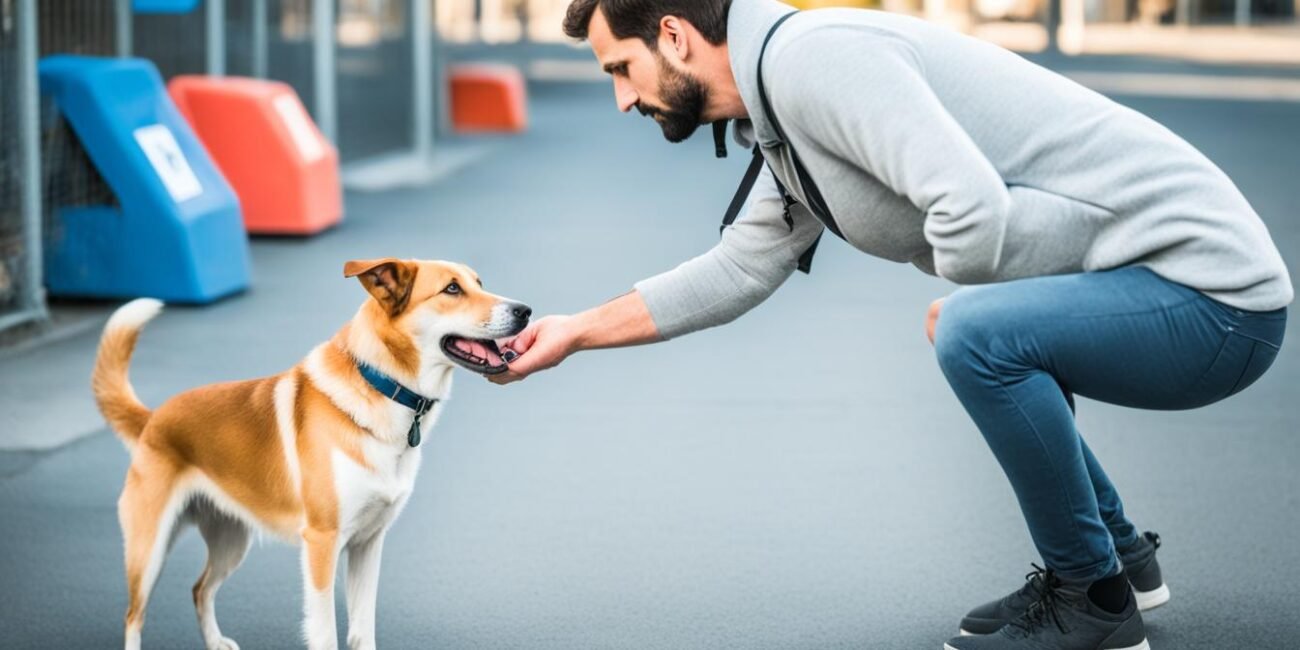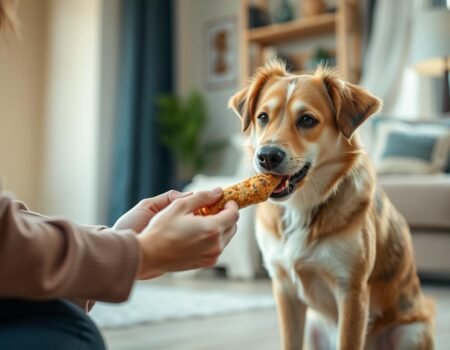Safe Tips: How to Catch a Stray Dog Easily
Did you know that there are millions of stray dogs worldwide? These abandoned and lost dogs often roam the streets, facing danger and uncertainty every day. If you come across a stray dog in need, it’s important to know how to safely catch them and provide the help they deserve. In this article, we will share valuable tips, techniques, and strategies for catching stray dogs without causing harm or distress.
Key Takeaways:
- Be patient and use gentle approaches when trying to catch a stray dog.
- Have the necessary equipment, such as a slip lead and tasty treats, to entice the dog.
- Avoid chasing the dog or making sudden movements, as it can cause fear and avoidance.
- Contact local authorities or animal control for assistance if needed.
- Remember to prioritize safety for both yourself and the stray dog throughout the capture process.
Things to Keep Handy
When it comes to catching a stray dog, having the right equipment and items on hand can make a significant difference in a successful capture. Here are some essential items to consider:
- A Slip Lead: A slip lead is a crucial tool for safely securing a stray dog. Unlike a regular collar, a slip lead is designed to tighten around the dog’s neck when tension is applied, providing a more secure hold without choking the dog.
- Treats or Smelly Food: Treats or smelly food can be incredibly effective in enticing a stray dog to approach you. The scent and taste of delicious treats can pique their curiosity and encourage them to come closer.
When attempting to catch a stray dog, it’s important to keep in mind some key principles:
- Avoid Sudden Movements: Sudden movements can startle and scare a stray dog, causing them to flee. Instead, make slow and deliberate movements to help gain their trust.
- Avoid Direct Eye Contact: Direct eye contact can be intimidating to dogs, especially those who are fearful or anxious. Instead, avert your gaze and avoid staring directly at the dog.
- Make Small Noises: Gentle sounds such as soft clucking or clicking can help alert the dog to your presence without overwhelming them. These noises can also serve as a way to engage their curiosity and encourage them to investigate.
“Having the right equipment and using the appropriate techniques can greatly increase your chances of capturing a stray dog safely and effectively.”
Remember to approach each stray dog with patience and respect their boundaries. Allow them to approach you at their own pace, and avoid trying to grab them forcefully. Building trust takes time, but with the right equipment and techniques, you can create a safer and more successful environment for both the dog and yourself.
What Not to Do when Catching a Stray Dog
When it comes to catching a stray dog, there are certain mistakes that should be avoided to ensure a successful capture. Taking the wrong approach can frighten the dog and make it even more difficult to gain their trust. Here are some things to avoid when trying to catch a stray dog:
- Grabbing the dog: It’s important not to grab the dog suddenly, as this can startle them and potentially lead to aggression. Instead, focus on building a relationship based on trust and positive reinforcement.
- Running after the dog: Chasing a stray dog is counterproductive and can cause the dog to panic and run even further away. Instead, move slowly and calmly to avoid triggering their flight response.
- Sneaking up on the dog: Approaching a stray dog without their awareness can startle them and cause them to bolt. Make your presence known by making small noises or calling out gently to alert them of your presence.
- Making direct eye contact: Dogs can perceive direct eye contact as a threat or challenge. Avoid staring directly into their eyes, as this can make them feel uncomfortable or defensive. Instead, allow the dog to approach you on their terms.
- Feeding the dog: While it may seem like a kind gesture, feeding a stray dog can deter their capture. They may become reliant on the food source and avoid getting too close to ensure their access to food. Save the treats for when the dog is safely in a controlled environment.
By avoiding these mistakes, you can create a more positive and trusting environment for the stray dog. Patience, calmness, and respect for the dog’s boundaries are key to successfully capturing a stray and providing them with the help they need.
| Mistakes to Avoid | Reasons to Avoid |
|---|---|
| Grabbing the dog | Can lead to aggression and fear |
| Running after the dog | Causes panic and makes capture more difficult |
| Sneaking up on the dog | Startles the dog and can trigger flight response |
| Making direct eye contact | Perceived as a threat or challenge |
| Feeding the dog | Deters capture and reliance on food source |
Remember, a gentle and patient approach is key when trying to catch a stray dog. Building trust and establishing a positive rapport will increase the chances of successfully capturing the dog and providing them with the care and support they need.
What to Do When Catching a Stray Dog
When it comes to catching a stray dog, there are several best practices and recommended actions to follow. By taking the right steps, we can increase the chances of a successful capture while ensuring the safety of both ourselves and the dog.
- Call for Help: If you feel uncomfortable or unsure about pursuing the stray dog yourself, it’s important to reach out to animal control or the local sheriff’s department for assistance. These professionals have the necessary expertise and resources to handle the situation safely.
- Be Mindful of Your Surroundings: Before approaching the stray dog, assess your surroundings. Look out for nearby roads or other potential hazards that could pose a danger to you or the dog. It’s crucial to choose a location that provides a secure and controlled environment for the capture.
- Moving Slowly and Speaking Softly: Scared dogs can be easily startled, so it’s important to approach them calmly and gently. Move slowly and speak softly to help create a sense of trust and security. Sudden movements or loud noises can trigger fear and make it harder to catch the dog.
- Allow the Dog to Come to You: Instead of chasing or aggressively pursuing the stray dog, allow them to come to you on their own terms. Make yourself approachable and non-threatening by crouching down and extending a hand for sniffing. This approach can help build rapport and increase the likelihood of a successful capture.
- Engage in Play: Using a ball or frisbee can be a great way to engage the stray dog in play. By enticing them with a fun and interactive toy, you can create a positive association and draw them closer to you. Play can also help alleviate any apprehension or fear the dog may have.
Additionally, there are a few extra steps you can take to improve your chances of locating the dog’s owner:
Leaving out food and a familiar item with your scent can help in establishing trust and making the dog feel more comfortable approaching you. Additionally, posting a description and photo of the dog on social media platforms and local community groups can help spread the word and potentially bring the dog’s owner forward.
Tips for Catching a Stray Dog
| Tip | Description |
|---|---|
| Call for Help | Contact animal control or the local sheriff’s department if you are uncomfortable pursuing the stray dog on your own. |
| Be Mindful of Surroundings | Assess the environment for potential hazards and choose a secure location for the capture. |
| Moving Slowly and Speaking Softly | Approach the dog calmly, move slowly, and speak softly to avoid startling or scaring them. |
| Allow the Dog to Come to You | Let the dog approach you on their own terms, crouching down and extending a hand for sniffing. |
| Engage in Play | Use a ball or frisbee to engage the dog in play, creating a positive association and drawing them closer to you. |
Tips for Catching a Shy or Panicked Lost Dog
When it comes to dealing with a shy or panicked lost dog, we need to approach the situation with patience and care. These dogs may be frightened or disoriented, so it’s crucial to create a calm and reassuring environment to increase our chances of capturing them safely. Here are some techniques and strategies to help you in catching a frightened lost dog:
- Remain still and avoid sudden movements: Sudden movements can startle a shy or panicked dog, causing them to run away or become aggressive. By staying calm and motionless, you can help put the dog at ease and minimize their fear.
- Use calming signals: Dogs communicate through body language, and using calming signals can help establish trust with a frightened dog. Yawning, blinking, and approaching them from the side instead of head-on can convey that you pose no threat.
- Employ a “magnet dog” technique: Sometimes, a friendly and playful dog can serve as a powerful lure to attract a lost dog. Having a well-behaved dog accompany you can help make the lost dog feel safer and more inclined to approach.
- Consider setting up a trap: If all other techniques fail, setting up a trap can be a viable option. Traps designed specifically for catching lost dogs can provide a safe way to capture them without causing additional distress.
Catching a shy or panicked lost dog requires a gentle and thoughtful approach. By implementing these techniques and strategies, you can increase the chances of successfully capturing the dog and ultimately reuniting them with their rightful owner.
“When dealing with a shy or panicked lost dog, it’s important to approach the situation with patience and care.”
| Techniques for Catching a Shy or Panicked Lost Dog | Advantages |
|---|---|
| Remain still and avoid sudden movements | Minimizes fear and promotes trust |
| Use calming signals | Establishes a non-threatening presence |
| Employ a “magnet dog” technique | Enhances comfort and encourages the lost dog to approach |
| Consider setting up a trap | Provides a safe capture method as a last resort |
How to Catch a Stray Dog Without Chasing Them
Capturing a stray dog can be challenging, especially if chasing them only makes them run further away. That’s why it’s important to approach the situation with a different strategy. Instead of chasing the dog, try using playful techniques to entice them to come to you.
One effective method is to run away from the dog as if you’re playing a game. Dogs have a natural instinct to chase, so by running in the opposite direction, you may pique their curiosity and encourage them to give chase. This approach can be more inviting and less intimidating than chasing after them.
When approaching the dog, make sure not to go directly towards them. This may be seen as a threat and cause them to retreat. Instead, use calming signals such as speaking softly, avoiding direct eye contact, and approaching from a side angle. These signals help convey that you are not a threat and can help build trust with the dog.
Another effective technique is to engage in playful activities with a ball or frisbee while ignoring the dog. Dogs are naturally curious and may be enticed by the fun and excitement happening nearby. This can capture their interest and increase the chances of them approaching you voluntarily.
Remember, every dog is unique and may have different responses. It’s important to be patient and adaptable in your approach. Only use techniques that feel safe for both you and the dog, and always prioritize their well-being.
Using Food to Catch a Stray Dog
Food can be a powerful tool when it comes to capturing a stray dog. By using tempting treats, you can entice the dog to come closer and increase your chances of successfully catching them.
One effective technique is to crinkle a bag and pretend to have treats. The noise will catch the dog’s attention and pique their curiosity. This can create a sense of anticipation, making them more likely to approach you.
Pro Tip: Make sure to use treats that are tasty and have a strong smell. Hotdogs, pizza, or meat are excellent options that can lure a stray dog with their enticing aroma.
Another method is to drop bits of food on the ground and pretend to search for them. This can simulate a scavenging behavior that stray dogs are familiar with. As they see you looking for food, they may come closer to investigate and potentially be caught.
Sitting on the ground and offering food while avoiding direct eye contact can help build trust with the stray dog. By positioning yourself at their level and displaying non-threatening body language, you can create a more inviting and safe environment for them.
Here’s an Example of Using Food:
| Technique | Description |
|---|---|
| Crinkling a Bag | Pretend to have treats by crinkling a bag. The sound will attract the dog’s attention. |
| Dropping Food | Drop bits of food on the ground and pretend to search for them. This will entice the dog to come closer. |
| Sitting on the Ground | Position yourself at the dog’s level and offer food while avoiding direct eye contact. This builds trust and encourages them to approach. |
By using food strategically, you can create an enticing and positive experience for the stray dog. Remember to be patient, calm, and always prioritize the safety of yourself and the dog.

Using a Dog Catch Pole to Securely Capture a Stray Dog
A dog catch pole is a humane tool that can be used to safely capture a stray dog, especially if it displays aggressive behavior. When handling a potentially aggressive dog, safety should always be the top priority. It is essential to have the necessary experience and knowledge to handle a dog catch pole effectively. This tool should only be used by trained professionals or individuals who have received proper instruction on its safe and responsible use.
The dog catch pole consists of a long pole with a loop or noose attached at one end. The loop is quickly and carefully placed around the dog’s neck, allowing for control and restraint without causing harm. It’s important to keep in mind that the goal is to safely secure the dog, not to cause unnecessary discomfort or pain.
Once the catch pole is securely around the dog’s neck, it can be used to guide the dog into a crate or a confined space for transport. This ensures the safety of both the dog and the capturer during transportation.
During the capturing process, it is crucial to avoid making direct eye contact with the dog. Eye contact can be seen as a threat by the dog, potentially escalating the situation and leading to further aggression. Instead, maintain a calm and assertive demeanor while focusing on safely securing the dog.
Using a dog catch pole requires caution, skill, and an understanding of dog behavior. The goal is to minimize stress and harm to the dog while ensuring the safety of everyone involved. If you are not confident in your ability to use a dog catch pole or if the dog’s behavior is too unpredictable, it is best to seek assistance from professionals such as animal control or a local shelter.
| Benefits of Using a Dog Catch Pole | Considerations for Using a Dog Catch Pole |
|---|---|
|
|
Setting Traps to Catch Stray Dogs
Traps can be an effective way to catch stray dogs. By using traps, we provide a safe and controlled environment for capturing these dogs without causing harm to them or ourselves. Here are some effective trapping methods for catching stray dogs:
1. Choosing the Right Location
To maximize the chances of success, it’s important to place the traps in areas frequented by the stray dogs. Look for places where they are known to gather or where they have been spotted before. This increases the likelihood of the dog encountering the trap.
2. Creating a Comfortable Environment
Stray dogs can be cautious and wary of unfamiliar objects, so it’s crucial to create a comfortable and inviting environment inside the trap. Using blankets to cover the trap helps to create a sense of safety and security for the dogs. This can increase their willingness to enter the trap.
3. Using Tasty Food as Bait
One of the most effective ways to attract stray dogs into the trap is by using tasty and smelly food as bait. Choose food that the dogs are likely to find irresistible, such as canned meat or dog treats. Place the bait inside the trap, making sure it is easily accessible and visible to the dogs.
4. Hiding the Trap Mechanism
To avoid detection and suspicion from the dogs, it’s important to hide the trap mechanism as much as possible. Make sure the trap blends in with its surroundings and appears less threatening to the dogs. This increases the chances of them entering the trap without hesitation.
5. Regularly Checking the Trap
Once the trap has been set, it’s essential to check it regularly to prevent other animals from accidentally getting trapped. Regular monitoring also allows for the timely release of any non-target captures. This helps us to maintain the effectiveness and ethicality of our trapping methods.
Remember, setting traps should always be done with the utmost care and consideration for the safety and well-being of both the stray dogs and the people involved in the capture process. By employing these effective trapping methods, we can improve the success rate of catching stray dogs and provide them with the care and assistance they need.
| Effective Trapping Methods for Catching Stray Dogs |
|---|
| 1. Choose the Right Location |
| 2. Create a Comfortable Environment |
| 3. Use Tasty Food as Bait |
| 4. Hide the Trap Mechanism |
| 5. Regularly Check the Trap |
Reporting and Returning a Found Stray Dog
When we come across a stray dog, it is crucial to take the necessary steps to report the situation and ensure that the dog is returned to its rightful owner. By following the appropriate protocols, we can help reunite these lost dogs with their loving families.
To begin, it is important to report the found stray dog to the local authorities, such as the local animal control or animal shelter. They have the resources and expertise to assist in locating the dog’s owner. Additionally, we can put up signs in the area where the dog was found, provide a description of the dog, and post on animal rescue sites to increase the chances of reuniting them with their owner.
It is vital to be mindful of and adhere to local regulations regarding stray dogs. Each jurisdiction may have different procedures for reporting and returning lost pets. By following the proper procedures, we can ensure that the dog is returned to its owner without any legal or ethical complications.
“It’s our duty as compassionate individuals to report and take the necessary steps to return a found stray dog to its owner. By doing so, we can help alleviate the distress and worry that the dog’s family may be experiencing.”
Returning a lost dog to its owner not only brings joy and relief to the family but also prevents the dog from potentially ending up in a shelter or wandering the streets. It is a rewarding experience to contribute to reuniting a beloved pet with its owner.
| Steps for Reporting and Returning a Found Stray Dog |
|---|
| Report the found stray dog to the local animal control or animal shelter. |
| Put up signs in the area where the dog was found, providing a description of the dog. |
| Post on animal rescue sites to increase the chances of reuniting the dog with its owner. |
| Follow local regulations regarding stray dogs and return the dog without assuming ownership. |
By following these steps, we can play a significant role in reuniting lost dogs with their families. Our efforts can have a profound impact on the lives of both the dog and its owner.
Safety Precautions and Considerations
When it comes to catching stray dogs, safety should always be the top priority. It is crucial to ensure the safety of both the capturer and the dog throughout the process. To successfully capture a stray dog while minimizing potential risks, it is essential to follow responsible strategies and take necessary precautions.
1. Prioritize Personal Safety
Catching stray dogs can sometimes involve unpredictable behaviors, including aggression. It is important to avoid direct interactions with aggressive dogs, as it can put your safety at risk. If you encounter a dog displaying aggressive behavior, it is recommended to seek assistance from professionals, such as animal control or local authorities.
2. Be Mindful of Your Surroundings
Before attempting to catch a stray dog, take a moment to assess your surroundings. Ensure that there are no hazards nearby, such as busy roads or dangerous terrain. By being aware of your environment, you can minimize the chances of accidents or injuries during the capture process.
3. Approach with Caution and Calmness
When approaching a stray dog, it is important to adopt a cautious and calm approach. Sudden movements or aggressive behavior can frighten the dog and make it more difficult to capture. Instead, speak softly and move slowly, allowing the dog to feel more at ease in your presence.
4. Follow Local Regulations
Every jurisdiction may have specific regulations regarding the capture and handling of stray animals. It is crucial to familiarize yourself with these regulations and comply with them accordingly. By following local laws, you can ensure the capture process is not only responsible but also within the boundaries of what is legally acceptable.
5. Seek Professional Assistance
If you find it challenging to capture a stray dog safely on your own, do not hesitate to seek professional assistance. Animal control or local authorities have experience and resources to handle such situations effectively. They can provide guidance, tools, and expertise to ensure the responsible capture and handling of stray dogs.
By prioritizing safety, following responsible strategies, and considering these important precautions, you can approach the task of catching stray dogs with confidence and minimize potential risks. Remember, the safety and well-being of both the capturer and the dog are of utmost importance throughout the process.
Conclusion
Capturing stray dogs safely requires a combination of patience, caution, and effective techniques. By implementing the tips and strategies outlined in this guide, individuals can increase their chances of successfully apprehending a stray dog and potentially reuniting them with their owner. It is crucial to prioritize safety throughout the capturing process and to seek assistance when necessary.
Remember, collaboration and community involvement are key in making a positive impact in the lives of stray dogs and their communities. By working together, we can ensure the well-being of these animals and contribute to a safer and more compassionate environment for both humans and animals alike.
Whether it’s using treats, employing a catch pole, setting traps, or employing other methods, always approach the situation responsibly and with the animal’s best interests in mind. By taking these steps, we can provide a helping hand to these vulnerable creatures and give them the opportunity for a better life.
FAQ
How can I safely catch a stray dog?
When trying to catch a stray dog, it’s important to have a slip lead, treats, and to avoid sudden movements or chasing the dog. Instead, make small noises, avoid direct eye contact, and let the dog come to you. If possible, safely trap the dog in an area like a yard and use a familiar scent to lure them. It’s also beneficial to post on social media and contact animal control or the sheriff’s department for assistance.
What items do I need when catching a stray dog?
Some important items to have when catching a stray dog include a slip lead, which is more secure than a collar, and treats or smelly food to entice them. It’s crucial to avoid grabbing the dog suddenly, as this can scare them, and not to make direct eye contact, which is intimidating to dogs. Instead, make small noises to alert them of your presence and let them approach at their own pace.
What actions should I avoid when trying to catch a stray dog?
It’s important to avoid certain actions when trying to catch a stray dog. Don’t just grab the dog, as this can frighten them and lead to aggression. Additionally, running after the dog or sneaking up on them can cause them to panic and run away. Making direct eye contact or feeding them can also deter their capture. These actions can be counterproductive and make it harder to gain the dog’s trust.
What should I do when catching a stray dog?
When catching a stray dog, it’s important to call animal control or the sheriff’s department if you feel uncomfortable pursuing the dog yourself. Be mindful of your surroundings, such as nearby roads, and move slowly and speak softly to scared dogs. Allow the dog to come to you and consider using a ball or frisbee to engage them in play. Leaving out food, a familiar item with your scent, and posting on social media can also help in locating the dog’s owner.
How can I catch a shy or panicked lost dog?
When dealing with a shy or panicked lost dog, it’s important to remain still and avoid sudden movements. Calling the dog or patting your legs can be threatening to them. Use calming signals like yawning, blinking, and approaching from the side instead of head-on. Another technique is to use a friendly and playful dog, known as a “magnet dog,” to lure the lost dog closer. If all else fails, consider setting up a trap to safely capture the dog.
Is it possible to catch a stray dog without chasing them?
Chasing a stray dog is often counterproductive, as it can cause the dog to run further away. Instead, try running away from the dog as if playing a game, which may entice them to chase. Avoid approaching the dog head-on and use calming signals to convey that you are not a threat. Running away and playing with a ball or frisbee while ignoring the dog may also attract their interest and increase the chances of them approaching.
How can I use food to catch a stray dog?
Food can be a powerful tool for capturing a stray dog. Crinkling a bag and pretending to have treats or dropping food on the ground and pretending to search for it can attract the dog’s attention. Sitting on the ground and offering food while avoiding direct eye contact can help build trust. It’s important to use tasty and smelly food to entice the dog, such as hotdogs, pizza, or meat. This approach can make the dog more inclined to come closer and be caught.
How do I safely capture a stray dog with a dog catch pole?
A dog catch pole is a humane tool that can be used to safely capture a stray dog, especially if it displays aggressive behavior. It should only be used if it does not put the user’s safety at risk. The pole is quickly hooked around the dog’s neck, and they can be securely transferred to a crate for transport. Eye contact should be avoided during this process to prevent further aggression.
How can I set traps to catch stray dogs?
Traps can be an effective way to catch stray dogs. They should be placed in areas frequented by the dog, ensuring a comfortable and inviting environment. Blankets can be used to cover the trap and create a sense of safety. Tasty food should be placed inside to entice the dog, with the trap mechanism hidden to avoid detection. It’s important to check the trap regularly to prevent other animals from getting trapped.
What should I do if I find a stray dog?
When finding a stray dog, it’s important to report the dog to the appropriate authorities, such as the local animal control or animal shelter. Putting up signs, posting on animal rescue sites, and providing a description of the dog can increase the chances of reuniting them with their owner. It’s essential to follow local regulations regarding stray dogs and not assume ownership without proper procedures.
What safety precautions and considerations should I keep in mind when catching a stray dog?
Safety should always be a priority when attempting to catch a stray dog. It’s important to prioritize the safety of both the capturer and the dog. Avoid interactions with aggressive dogs and seek assistance from professionals when needed. Being aware of your surroundings, using cautious and calm approaches, and following local regulations are all important considerations to ensure a successful and responsible capture.
How can I catch a stray dog easily and responsibly?
Capturing stray dogs requires patience, caution, and responsible strategies. By following the tips and techniques outlined in this guide, individuals can increase their chances of safely catching a stray dog and potentially reuniting them with their owner. Remember to prioritize safety and seek assistance when necessary. By working together, we can make a positive impact in the lives of these stray dogs and their communities.












No Comment! Be the first one.